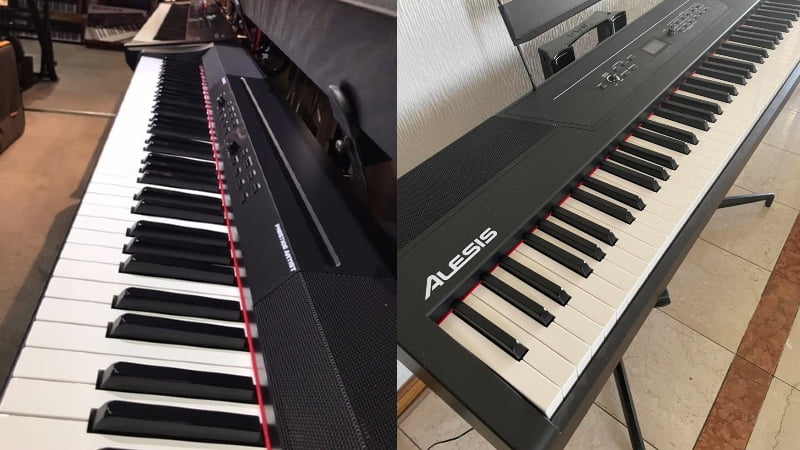Alesis is widely known for being one of the best digital piano brands out there. And in their extensive collection of great beginner pianos, namely the Alesis Prestige Artist and the Recital Pro.
When conducting this Alesis Prestige Artist vs Recital Pro comparison, I had a hard time finding a winner. However, by the end of it all, the Alesis Prestige Artist ultimately came out on top because of better tone generation and better compatibility that makes it a great choice for just about any pianist out there.
However, for a very low price, the Alesis Recital Pro offers a wide range of different functions. Aside from a decent tone generator and sound library, the Recital Pro offers pianists a range of different effects to allow them to customize their tone. With all these features, it was very clear why the Alesis Recital Pro is one of the best beginner options on the market today.
Alesis Prestige Artist vs Recital Pro: Comparison Chart




Last update on 2025-07-10 / Affiliate links / Images from Amazon Product Advertising API
Alesis Prestige Artist vs Recital Pro: Differences
Since these two pianos are fairly similar, I figured the best way to determine a winner was to compare all the different features. Each of the pianos had its own strengths, but in the end, the Alesis Prestige Artist simply had more to offer and beat out the Recital Pro with a score of 3-1. The different piano features and better sound library of the Alesis Prestige Artist were too much for the Recital Pro to handle, which is why the former is the definitive winner.
Feel
The winner: Tie
In terms of how the piano feels, these two are very similar. They both have fully-weighted hammer action and glossy keys, and when trying them out blindly, I could barely tell the difference between either piano. So, in the end, it was a clear tie between these two options.
+ Hammer Action
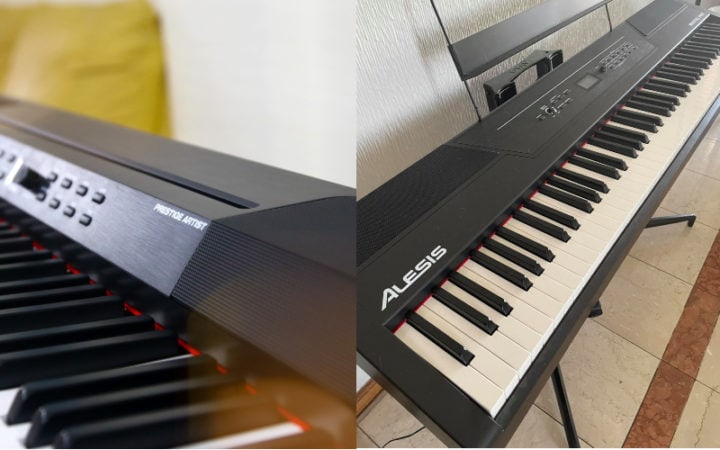
Both of these pianos have fully-weighted keys. This is great for mimicking the feel of an acoustic piano. However, the Alesis Prestige Artist has a slight edge in terms of feel because it uses graded hammer action. While the Recital Pro features the same consistent hammer action all throughout the piano, the Prestige Artist has heavier keys on the left side that get progressively lighter as you go up on the keyboard.
The progressive hammer action is much more realistic than standard fully-weighted keys. It also makes it much easier to play the piano since the higher keys are significantly lighter than the lower keys. With that said, I still noticed that the Alesis Prestige Artist had fairly heavy hammer action, which may not be ideal for some beginners and pianists.
The fact that the Alesis Recital Pro doesn’t have graded hammer action isn’t a knock on its quality. Since the Recital Pro is a much more affordable keyboard, it’s expected not to have graded hammer action.
+ Key Texture
The main reason these pianos are tied in terms of feel is because the Alesis Prestige Artist has glossy keys. For a piano in its price range, this is fairly disappointing. Glossy keys are fine for entry-level pianos like the Recital Pro, as it keeps the piano from fetching a very high price tag. However, for a piano in the range of the Alesis Prestige Artist, I expected some sort of coating to mimic the feel or real wooden keys, and I was let-down.
Now, if you’re a beginner, there’s a high chance you won’t notice the difference between glossy and matted or coated keys. But as you start playing faster and more complicated pieces of music, the key texture becomes more evident and becomes a major knock on the Recital Pro’s quality.
Tone
The winner: Alesis Prestige Artist
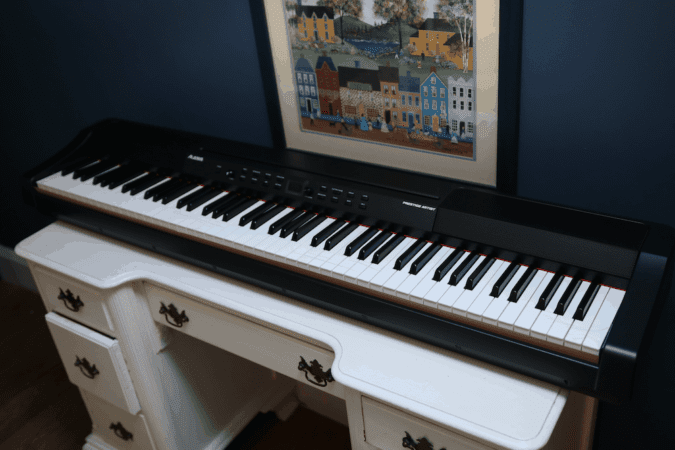
In terms of tone, there was no other winner but the Alesis Prestige Artist. While the Recital Pro has a tone that exceeds its price range, it could not match the Multi-Sampled voices and the extensive sound library on the Alesis Prestige Artist.
+ Tone Generation
The first reason I found the Alesis Prestige Artist to have superior tone is the tone generator itself. The Alesis Prestige Artist uses multi-sampled voices for its tone. This method involves playing a couple of different samples whenever you press down on the key. These are all samples of the same instrument, and give out a more rounded, accurate, and stereo sound. The result of the multi-sampled voices is a much clearer and accurate tone that sounds very similar to an acoustic piano. While there were some tones in the voice library that sounded a bit digital, it was still much more accurate than most other options out there.
The Alesis Recital Pro uses the standard sampling tone generation method. Now, this isn’t bad at all for a piano in this price range. However, it does result in a fairly digital and thin tone that leaves a lot to be desired. If you’re a beginner, this might not matter too much since you’re just getting a hang of the instrument, but it does become more evident the more you play the piano.
So, if you’re on the hunt for a digital piano with a very accurate and rich set of tones, then the Alesis Prestige Artist is the better option hands-down.
+ Sound Library
One of the things that impressed me the most with the Prestige Artist was the robust sound library. On the Alesis Prestige Artist, you get 30 different and distinct voices. This is way more than you’ll get even from pianos in the same price range. The tones fall under the same general categories such as acoustic piano, electric piano, synth, strings, and bass, which is more than enough for any beginner. In fact, even if you’re a professional pianist performing with a band, you’ll find that this option offers a whole lot of versatility when it comes to the sound.
You have multiple choices in each category, which allows you to play around and experiment until you find just the right one for you. With the Alesis Recital Pro, on the other hand, you have a very limited library with only 12 different voices.
If you’re a beginner pianist starting their first piano lessons, 12 voices should be more than enough to get you by. However, it doesn’t give you enough room to experiment with a bunch of different sounds and find the tone that suits your style of music. So, if and when you start performing and playing with other musicians, you might need to upgrade the Recital Pro to a piano with more versatility.
Piano Features
The winner: Alesis Prestige Artist
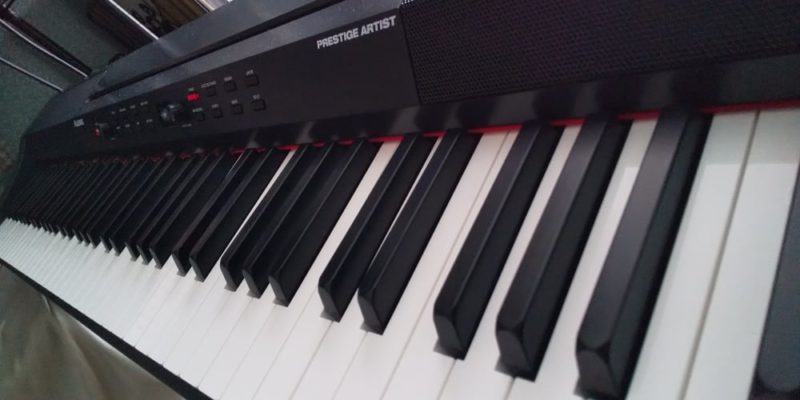
The Alesis Recital Pro came with a set of piano features that was honestly very surprising. It had a variety of playing modes and MIDI connectivity, which would usually make it beat out just about any other piano in its range. However, since the Prestige Artist has better polyphony and even more connectivity options than the Recital Pro, the Prestige Artist was the easy winner in this comparison.
+ Playing Modes
Both of these pianos come with the same playing modes, which is a huge surprise considering their price difference. On both pianos, you have lesson, layer, and split playing modes. Each of these have their own applications when it comes to performing and learning music, and are all great things for any beginner’s piano.
Let’s start with lesson mode. In this mode, you can separate the piano into two mini-keyboards with the exact same pitch and voice. The reason this is a valuable mose is because it allows you to either play piano duets or have a teacher demonstrate different techniques without having to cross over to the other side of the piano.
With layer mode, you can layer two voices on top of each other. This creates a very unique sound that you may not find when loading a single voice. This is especially useful for accompanists as you can load strings and piano voices at the same time, which adds a new layer of depth.
With split mode, you can divide the piano into two mini keyboards again, the difference being each side has a different voice. This is a very fun feature that also has a bunch of practical uses. For example, if you’re playing solo, you can load strings voices on the left side and a piano voice on the right side, allowing you to give the illusion that you’re playing multiple instruments at the same time.
One additional mode that’s on both pianos that wasn’t mentioned earlier is recording. Both of these pianos can record your playing and play it back so you can hear where you need to make adjustments. And while it’s great for rehearsals, the piano doesn’t record the sound well enough to use the recordings for studio-quality songs.
+ Polyphony
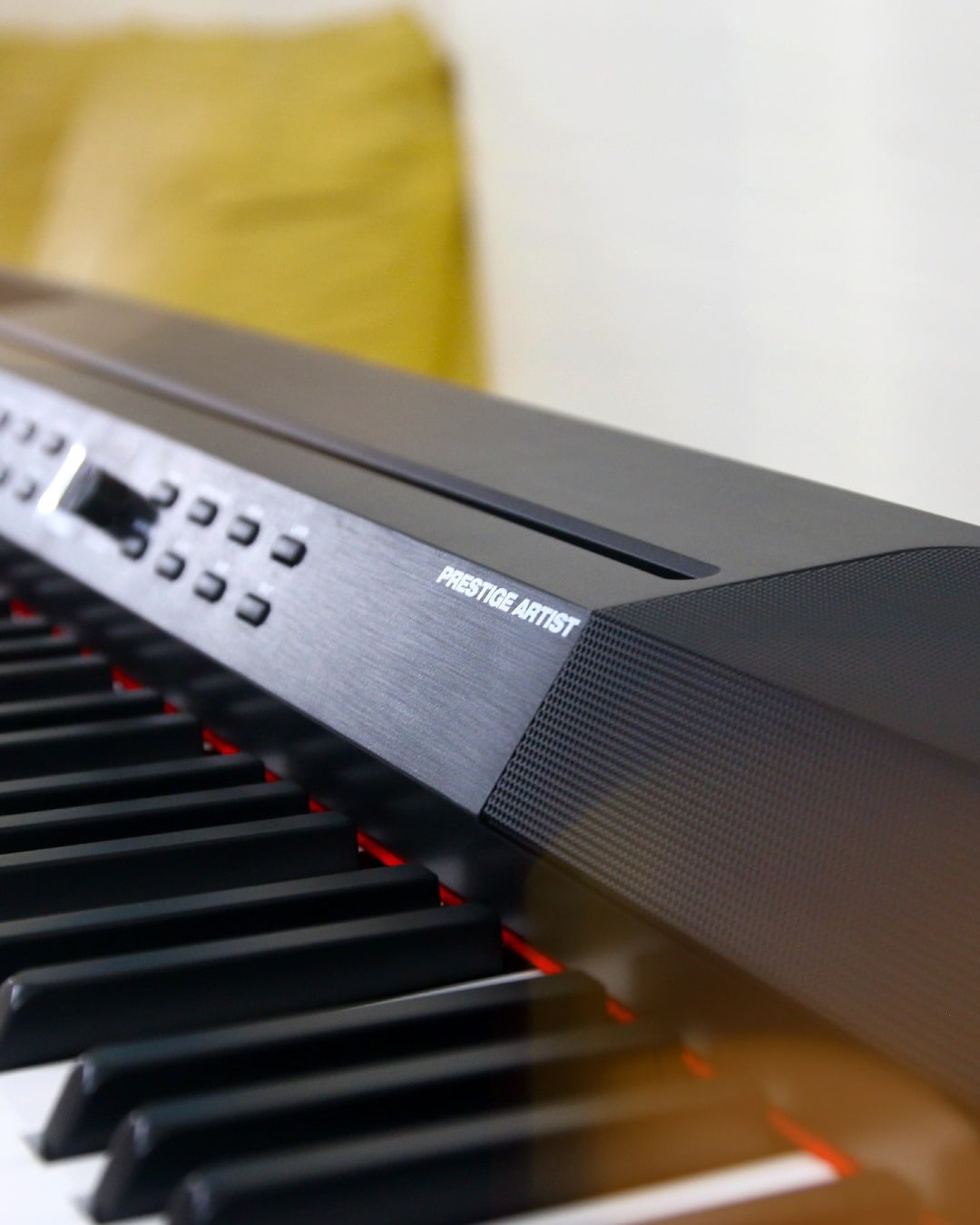
In terms of polyphony, the Alesis Prestige Artist blows it out of the park. It has double the polyphony of the Recital Pro, which should give you a lot more versatility when playing. Sadly, that isn’t exactly the case. While the Alesis Prestige Artist has a maximum polyphony of 256, since you’re playing multiple samples every time you press a key, the polyphony in practice is actually closer to 128, which is the same as the Recital Pro.
However, with either of the pianos, you can play very dense and spread out choices even with the sustain pedal on, which is very important for beginners and experienced pianists alike.
+ Connectivity
One advantage of both these pianos is MIDI connectivity. This allows you to use the instruments in new ways by plugging it into your computer. You can use the piano to control virtual instruments, or you can even use it for piano learning apps that give you useful tips and techniques to use in your playing.
However, the reason that the Alesis Prestige Artist wins in terms of piano features is the extra connectivity options. With the Alesis Prestige Artist, you can plug in a three-pedal unit. That way, you have a sustain pedal, damper pedal, and a soft pedal, just like with an acoustic piano.
Alesis Prestige Artist vs Recital Pro: The Similarities
While the Alesis Prestige Artist is more expensive than the Recital Pro, they are made for the same type of pianist, which is the first similarity that the two share. These are both great beginner pianos, however, since the Prestige Artist has a couple of extra useful features, it might be able to last you a longer time.
On top of that, these are buth full-size 88-key pianos with graded hammer action. They both replicate the feel of an acoustic piano fairly well, which is a major point in either of their favors. Additionally, it was a pleasant surprise that these pianos shared the same playing modes, which are all very useful.
Both pianos offer MIDI connectivity, which is a very important feature as it allows you to use the piano as a MIDI controller for piano learning apps and even to control virtual instruments on your computer.
However, that’s about where the similarities end. Since they have a bunch of differences, they are usually compared side by side against each other. And if you’re looking for a piano that’s good for both beginners and novices, you’ll probably find the Alesis Prestige Artist to be a better bargain at the end of the day.
Quick Rundown of the Alesis Prestige Artist
- It’s Time to Upgrade your Electric Piano – 88 key piano keyboard with graded hammer action and adjustable touch response for a natural piano feel - for beginner, intermediate and advanced players
- Packed with Premium Sounds - 30 multi-sampled voices including Grand Piano, Electric Piano, Organ, Synthesizers & more; simultaneous Split & Layer modes; built-in arpeggiator; 5 adjustable Reverb FX
- Authentic Playing Experience - 256 max polyphony provides a superb 88 key piano playing experience; 50W micro-array speaker system sounds loud, clear and realistic in any setting
- Stage Piano Essentials – OLED screen for intuitive control; Stereo 1/4” outputs; 1/4” and 1/8” (3.5mm) headphone outputs; USB-MIDI output for use with educational software or virtual
- The Complete Full Size Keyboard Piano Experience - Piano style sustain pedal, music rest, and power adapter included; Lesson & Record Modes to develop your electric keyboard piano skills
Last update on 2025-07-10 / Affiliate links / Images from Amazon Product Advertising API
Quick Rundown of the Alesis Recital Pro
- A Digital Piano That’s Tailored to You - Feature-packed electric keyboard with 88 premium full-sized weighted hammer action keys with adjustable touch response to suit your preferred playing style
- Premium Sounds - 12 voices (Incl. Acoustic Piano, Electric Piano, Organ, Synth, and Bass), built-in FX: Chorus, Modulation, Reverb, and two built in 20W speakers for clear, room-filling sound
- All The Right Connections - ¼” sustain pedal input (pedal not included), ¼” stereo headphone output for private practice and stereo outputs for connection to speakers / amplifiers
- Play the Keyboard Wherever You Go - Power via the included power adapter or 6 D cell batteries (not included) for professional piano performance anywhere
- Powerful Educational Features - Standard, split, layer, record and lesson modes with 128-note max polyphony and Skoove 3 month premium subscription for expert interactive online piano lessons
Last update on 2025-07-09 / Affiliate links / Images from Amazon Product Advertising API
Product Videos
Related Articles to Alesis Prestige Artist
- Alesis Prestige Artist vs Korg B2: The Better $500 Digital Piano
- Alesis Prestige Artist vs Yamaha P125 Comparison: Why the Yamaha P125 Is the Better Investment
- Alesis Prestige Artist vs Yamaha P45: Can Alesis Hold Its Own Against the Popular Yamaha Model?
- Alesis Prestige Artist vs Roland FP-10: Which Is the Best Beginner’s Digital Piano?
- Alesis Prestige vs Prestige Artist: Can the Alesis Prestige Hold Its Own Against the Upgraded Prestige Artist?
Related Articles to Alesis Recital Pro
- Alesis Recital Pro vs Williams Legato III: Discover the Best Piano for Your Home
- Alesis Recital Pro vs Roland Go Piano 88 Comparison: Which Is The Best Portable Digital Piano?
- Alesis Recital Pro vs Yamaha NP32 Comparison: Discover the Best Piano for Your Home
- Kawai ES110 Vs Alesis Recital Pro: Should You Shell Out for the Kawai ES110?
- Alesis Recital Pro vs Prestige Comparison: Choosing the Best Entry-Level Alesis Piano
- Alesis Recital Pro vs Casio CDP-135: Which Is the Best Beginner’s Digital Piano?
- Alesis Recital Pro vs Roland FP-30: Finding the Best Digital Piano on a Budget
- Alesis Recital Pro vs Casio CDP-S150 Comparison: Which Is The Best Portable Digital Piano?
- Alesis Virtue vs Recital Pro: Which Piano Offers The Most For Beginners?
- Alesis Recital Pro vs Casio PX 160: Which Piano Comes Out On Top?
- Alesis Recital Pro vs Roland FP 10: Why You Should Go For The Alesis Recital Pro
- Alesis Recital Pro vs Korg B2 Comparison: Which Digital Piano Should You Get?
- Alesis Recital Pro vs Williams Allegro 3 Comparison: Which One Is Worth Your Money?
- Alesis Recital Pro vs Yamaha P125 Comparison: Which Is The Best Portable Digital Piano?
- Alesis Recital vs Alesis Recital Pro: Should You Invest In The Recital Pro?
- Alesis Recital Pro vs Yamaha P45: Which Should You Get As Your First Piano?
- Donner DEP-20 vs Alesis Recital Pro Comparison: Two Great Pianos Designed for Beginners
- Yamaha P71 vs Alesis Recital Pro: Which Digital Piano is the Best Option for Beginners?
References:
- RECITAL PRO 88-Key Digital Piano with Hammer-Action Keys: https://www.alesis.com/products/view/recital-pro
- Alesis Prestige Artist 88-key Digital Piano w/ Graded Hammer Action Keys: https://www.sweetwater.com/store/detail/PrestigeArt–alesis-prestige-artist-88-key-digital-piano-with-graded-hammer-action-keys
Lulacruza is an electronic folk duo operating at the junction of the hypermodern and the ancient. Our music weaves together hypnotic female singing, South American folk instruments and electronic processing, while channeling pulsating waves from the source of creation.
Lalucruza is also a community where you can connect with other music lovers to collaborate, exchange ideas and share knowledge. A platform for who wants to learns the basics of playing piano, guitar, drum masters’ technique, etc.. is the premise of our website.
